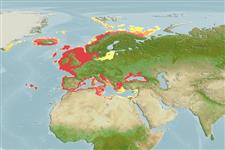Gastropoda |
Not assigned |
Cerithiidae
Environment: milieu / climate zone / depth range / distribution range
Ecology
Benthic; depth range 0 - 250 m (Ref. 78574). Subtropical; 73°N - 21°N, 33°W - 42°E
Northeast Atlantic and the Mediterranean.
Length at first maturity / Size / Weight / Age
Maturity: Lm ? range ? - ? cm Max length : 1.0 cm TL male/unsexed; (Ref. 78574)
Collected from the sublittoral zone, from low tide up to a depth of 200 m (Ref. 2754). A microalgae herbivore (Ref. 96488). This is an epibenthic species found on reefs (Ref. 95730). It is one of the most abundant microgastropods inhabiting the alga Gelidium latifolium and prefers to live at the base of the plant (Ref. 96520).
Life cycle and mating behavior
Maturity | Reproduction | Spawning | Eggs | Fecundity | Larvae
Members of the order Neotaenioglossa are mostly gonochoric and broadcast spawners. Life cycle: Embryos develop into planktonic trocophore larvae and later into juvenile veligers before becoming fully grown adults.
Demir, M. 2003 Shells of mollusca collected from the seas of Turkey. Turkey Journal of Zoology 27:101-140. (Ref. 2754)
IUCN Red List Status
(Ref. 130435: Version 2025-1)
CITES status (Ref. 108899)
Not Evaluated
Not Evaluated
Threat to humans
Human uses
| FishSource |
Tools
More information
Trophic EcologyFood items (preys)Diet compositionFood consumptionPredators Population dynamicsGrowth
Max. ages / sizes
Length-weight rel.
Length-length rel.
Length-frequencies
Mass conversion
Abundance
Life cycleReproductionMaturityFecunditySpawningEggsEgg developmentLarvae PhysiologyOxygen consumption
Human RelatedStamps, coins, misc.
Internet sources
Estimates based on models
Preferred temperature
(Ref.
115969): 6.7 - 15.7, mean 9.8 (based on 632 cells).
Fishing Vulnerability
Low vulnerability (10 of 100).
Price category
Unknown.
